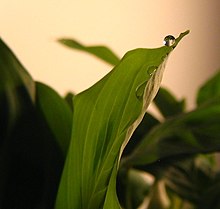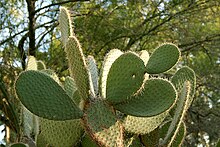Water balance of plants
The water balance of a plant summarizes all processes and processes that enable plants to deal with the available water at their respective locations . External influencing factors are v. a. the type of soil , the prevailing climate as well as the type of terrain and soil moisture .
The term refers to an interface between morphology , botanical anatomy , metabolism and ecology .
Overview
Since plants cannot leave their location for a short time, they are more dependent than animals on managing the water that is currently available. Only aquatic plants have no protection against water loss. However, in individual cases these can survive periods of water shortage as permanent forms. Plants usually have a high water content because their charge-carrying components of the cytoplasm must be in a hydrated form. A sufficient water content of the tissue is also necessary for the transport processes in the xylem and phloem (woody conductive tissue and sieve elements), as well as for osmotic movements and for photosynthesis .
In land plants is the water absorption mostly on the roots is limited, while the transpiration (water) mainly through the stomata (stomata) in the leaves and to a lesser degree on the cuticle is performed. The water is transported through the xylem . With very high humidity and persistently high root pressure , transpiration is no longer possible, so that the plant presses the water out directly via the hydathodes ; this process is called guttation .
According to the controversial and yet widely recognized cohesion theory of water transport by the plant physiologist Böhm , transpiration in the xylem creates a negative pressure that ensures the transport of water and minerals from the root system to the leaves. The suction is so great that it can lift a water column of> 10 m because the water in the capillaries holds together like threads. Among other things, however, osmosis or osmotic pressure, i.e. the gradient of the water potential, is responsible for the water transport over large differences in altitude. In u. a. Measurements have shown that the transpiration thesis for water transport in plants is not consistent over large differences in height.
Because plants not only transpire through the stomata, but also absorb CO 2 , which they process into glucose during photosynthesis , plants in extreme locations such as in the desert are faced with a dilemma : During the day, when sufficient light is available for photosynthesis , the stomata should be open to ensure CO 2 replenishment. However, then the risk of dehydration is greatest. From this point of view, the development of C4 plants and CAM plants can be better understood, which have anatomically and physiologically adapted to this dilemma in their carbon dioxide fixation .
Further developments of plants to regulate their water balance are, for example, the regression of leaves to reduce the surface area of cacti or the formation of wax layers to reduce cuticular transpiration.
In addition to the properties of the respective plant, the soil type and soil moisture , which in turn depend on the porosity , the climate and the slope of the terrain, are decisive for the water balance .
The following is an overview of the different ways plants adapt to the water available in their location:
Aquatic plants
Hydrophytes live in rivers, lakes or other aquatic habitats, there is leaf dimorphism (leaves that swim are large, leaves that submerge are small). These plants absorb water with their entire surface and have hardly any roots, as these do not play a role in nutrient and water uptake. They carry out photosynthesis via their leaves and stems and have few or no stomata, they absorb carbon dioxide in aqueous form as hydrogen carbonate ion (HCO 3 - ) over the entire surface. The long, ribbon-shaped, delicate leaves with a central vascular bundle are insensitive to tension, so that they do not tear off in the current. The strengthening and conductive tissue is hardly developed, so that the plant is mobile in the water.
A special feature are the floating leaf plants (e.g. water lilies), which stick to the ground with their roots, but whose leaves float on the surface. The root is only weakly developed, since it is not necessary for water and nutrient absorption, but only for location. Thanks to air chambers, the leaves are able to float on the water on the one hand, and on the other hand they ensure gas exchange in the roots so that they do not suffocate in the oxygen-poor mud. The stomata of the lily pad are on the top. The cuticle is missing or barely developed, which promotes evaporation.
Plants in moist locations
Plants in humid locations ( hygrophytes ) grow, for example, in rainforests or cloud forests ; due to the high water vapor pressure of their surroundings, even with the stomata opened to the maximum, they cannot generate enough transpiration to transport nutrient salts from the soil into the leaves. Therefore, they have developed anatomical changes that make perspiration easier. These adjustments include raised stomata that the wind can brush along. They also usually have thin, large leaves with a very thin or completely absent cuticle. The leaves show surface enlargement through fragmentation or grooves, which also facilitate the drainage of rainwater from the leaves. The leaves often have living hairs ( trichomes ), which also increase the transpiring surface. Some plants use the mechanism of guttation to excrete additional water, which also works with air that is saturated with water vapor.
Plants in alternately humid locations
These so-called mesophytes live in locations that are only occasionally moist, for example in rivers that periodically dry out. These plants go through a resting phase during the dry season, during which they shed the leaves or use the dried-out leaves as a cover for the delicate growth cone . The woody parts survive long dry phases. Some of these plants can absorb many times their dry weight in water within a short time through their surface when it rains.
Locations with alternating moisture in the broader sense are also areas that make it difficult to absorb groundwater in winter due to snow and ice. Plants that are adapted to cold winter areas are called tropophytes . The deciduous trees of Central Europe belong to them. However, this adjustment is only indirectly due to lack of water.
Plants in dry locations
In dry locations, for example in the savannahs of Africa or in the karst areas of the Mediterranean area, plants ( xerophytes ) can be found that restrict their transpiration through varied adaptation. They have a well-developed root system that extends to great depths or is spread over a wide area beneath the surface of the soil, so that rain can be absorbed quickly. The leaves are reduced in size, coarse (hard foliage) with a thick cuticle and a lot of strengthening tissue (sclerenchyme), so that they only slacken minimally when water is lost. Examples are the olive tree , the holm oak and the carob tree . The leaves have more stomata, but they are often sunken and can be protected from the drying wind by folding or rolling the leaves. In addition, a felt of dead "hair" often serves as protection against evaporation . Photosynthesis is possible due to the increased number of stomata even in very hot weather, because the large intercellular spaces are quickly filled with air rich in carbon dioxide and the stomata can then be closed again. The thick leaves are adapted to strong sunlight.
Plants in extremely dry locations
Desert plants can also take another route to survive. Succulents have a water storage tissue that lies inside the leaves or the trunk and is protected from being tapped by animals by means of stabilizing tissue. The surface of the plants is greatly reduced. If leaves are formed at all, they are thick and fleshy (leaf succulents). Often, however, the leaves are reduced to thorns (protection against eating) and the trunk is used as a water reservoir and photosynthetic organ (stem succulents). The stomata are sunk, in the case of stem succulents they lie in the grooves of the trunk, which are protected from wind and sun.
See also
Individual evidence
- ↑ https://www.spektrum.de/lexikon/biologie-kompakt/kohaesionstheorie-der-wasserleitung/6497 Spektrum-Verlag : Compact Lexicon of Biology: Cohesion Theory of Water Piping , accessed on 27 Sep. 2019
- ↑ http://bio1520.biology.gatech.edu/nutrition-transport-and-homeostasis/plant-transport-processes-i/ Shana Kerr: Water Transport from Roots to Shoots , in Biology 1520, Nov. 13, 2016, accessed on Sep 27 2019
- ↑ https://www.jstor.org/stable/55646?read-now=1&seq=1#page_scan_tab_contents U. Zimmermann, A. Haase, D. Langbein, F. Meinzer: Mechanisms of Long-Distance Water Transport in Plants: A Re-Examination of Some Paradigms in the Light of New Evidence , in Philosophical Transactions: Biological Sciences vol. 341, no. 1295, The Transpiration Stream (Jul 29, 1993), pp. 19-31, accessed Sep 27. 2019





